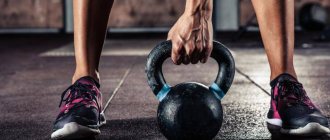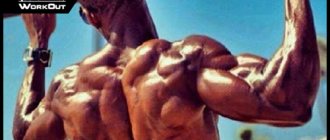Hello, lovers of sports and a healthy lifestyle. Do you want people turning around to admire you? Then read and take notes in your sports notebook. Everyone is familiar with the basic exercises for building muscle mass:
- Bench press.
- Squat with a barbell.
- Deadlift.
But there is one more thing for the back - these are pull-ups with weights on the bar. For results in gaining muscle mass, traditional pull-ups are not enough. The athlete’s muscles get used to it, thereby not receiving training stress and the impulse to grow in strength and volume. Additional weight will increase the load, which means it will force you to leave your “comfort zone”.
What kind of exercise is this?
In essence, these are the same hanging lifts, only with additional weight: with a chain or belt, to which plates from a barbell or dumbbells are tied.
When can you start lifting weights? For beginners, I recommend performing rows on the bar only after fully mastering the technique. The entrance test for admission is three approaches of 12 times. Each repetition is performed “cleanly”. Avoid jerking and swinging movements of the legs. If it comes easily to you, start exercising with weights.
“Hard” shoulders[edit | edit code]
Stiff Shoulders
All hanging exercises put stress on the arm joints, so it's important to know how to protect your shoulders and elbows from injury.
The shoulder joint is like a ball-and-socket joint—it has a ball-and-socket shape and allows for the greatest range of motion, from rotation to flexion. But the increased range of motion comes at the cost of decreased stability. If you relax your shoulders while hanging from a bar, the joint is stretched and held in place only by inflexible ligaments. Such actions not only cause damage to the ligaments, but also in some cases lead to partial or complete dislocation of the shoulder. It may not happen often, but it does happen, especially if the athlete has already been injured. Therefore, when doing pull-ups, you should tighten your muscles tightly, protecting the ligaments and avoiding unnatural bends in the elbows and shoulders.
Exercises in which the body hangs in the air, especially pull-ups with leg raises, are extremely effective, so it is important to master good technique from the very beginning of training. Keeping your shoulders stiff isn't that hard. To do this, you just need to lower your shoulder joints by five centimeters. Look at the picture - do you see the difference? This trick is easy to do if you tense your latissimus dorsi muscles. Keep your entire upper body tense during the exercise and you will succeed.
What muscles work?
When lifting the body to the crossbar, the following are used:
- Supraspinatus, infraspinatus, biceps and triceps brachii muscles.
- The levator scapulae muscle.
- Upper, lower parts of the trapezius muscle.
- Extensor carpi ulnaris and flexor carpi.
- The erector spinae muscle.
- Latissimus muscle.
Plus included in the work:
- Rectus abdominis muscle.
- Quadriceps and biceps femoris.
- Pectoralis major muscle.
Depending on the grip you choose, the load will vary.
Reverse and close grip - biceps and forearm.
A wide grip puts more stress on the latissimus muscles.
Big biceps[edit | edit code]
Even bodybuilders admit that pull-ups allow you to build back muscles, but not everyone knows that pull-ups are the most effective exercise for building biceps. Many people pump their biceps on the machine, forgetting that this exercise isolates all the auxiliary muscles, because it only works the muscles through the elbow joint. Pull-ups are a complex exercise in which the biceps are trained through the movement of two joints - the elbow and shoulder. This is how the biceps works naturally, and as a result, this small arm muscle becomes very strong when used in this way. The lats will carry out most of the load. But the biceps will be an essential part of a powerful basic movement and will be stimulated to the maximum. And then it will receive a hormonal response and maximum adaptation to this load. It’s no wonder that gymnasts have such powerful, well-defined biceps that look like a good melon! If you want to have the same one, put the barbells and dumbbells away. And start pulling yourself up!
The benefits and harms of pull-ups
Minimize the risk of harm to health by visiting a therapist first. If pathologies are detected, the doctor will develop a special program. Doctors do not always recommend hanging and doing pull-ups on an apparatus for people who have problems with the spine.
Positive sides:
- Correct posture.
- Prevention of spinal diseases.
- Muscle tone.
- Fast calorie burning.
Contraindications
The following health problems may interfere with exercise:
- Chronic diseases in acute form.
- Paralysis of arms and legs.
- Obesity.
- Heart failure.
- Poor blood flow to the brain.
- The presence of a hernia or protrusion.
What to pull yourself up with[edit | edit code]
Until the 19th century, all cells, especially in police stations, looked like cages made of thick steel bars. Prisoners of that time had no problem finding the crossbar. However, after some time, in order to avoid cases of suicide, the walls and ceiling of such cells began to be made solid. Therefore, today prisoners can only do pull-ups in specially designated areas. And you will also have to find something suitable.
The human body easily adapts, so pull yourself up using any suitable object - a tree branch, a heating pipe, the edge of a balcony. If you want to practice at home, secure the horizontal bar in the doorway. They are cheap and can be found in any store. Something higher, like a pipe coming down from the roof, is even better because you won't have to worry about raising your feet high enough. You can simply place a metal pipe on the attic door in the ceiling and perform leg raises on it.
Nevertheless, the best equipment for pull-ups is rings. You can buy them, or you can simply find rings that match the diameter of your fist, and a cable on which to attach them.
Techniques and types of pull-ups with weights
If you have learned the technique without weights, then there will be no difficulties. When working with cargo, consider the following nuances:
- Hang onto the horizontal bar from a stand without jumping.
- You can also go down through the stand.
- Eliminate rocking.
- Movements are smooth without jerking.
Use a vest as an additional load. The advantage over a weightlifting belt is that it does not put pressure on the spine.
- To ensure a secure grip, dry your hands with sports magnesium.
- Put on the weights and approach the horizontal bar so that it is above your head.
- Using a wall bars or stand, carefully perform the hang.
- As you exhale, bending your arms, smoothly rise to your chest.
- Pause briefly at the top, keeping your chin above the bar.
- As you inhale, controlling the fall of your body, lower yourself to a hanging position.
In order for your joints to get used to it, plan your first sessions using negative pulls.
- Stand on the bench so that your chin is above the bar.
- Bend your legs and lower yourself until your arms are almost bent at the elbows.
- Stand on the bench and take your starting position.
In addition to straight ones, when the crossbar touches the chest, pull-ups by the head are no less effective. I don't recommend it for beginners. Contraindicated for diseases of the cervical and shoulder girdle.
Content
- 1 Pull-ups on the horizontal bar 1.1 How to learn to do pull-ups (video)
- 1.2 Pull-up technique
Example workout
At home
The advantage of pull-ups is that you can do without a gym membership. Stretch your shoulders and hands. Jumping rope will perfectly warm up your whole body. A backpack with books works well as a weighting agent. Exercising with weights at home is not much different from training in the gym, which we will look at below.
In the gym
At the gym, warm up on the treadmill. Seven minutes of running will be enough to prepare the body for work. Do 2 - 3 pull-downs of the upper block to the chest for 6-8 repetitions. Choose a projectile weight of 60-70 percent of your own body weight. It is better to set aside a separate day to work out your back.
First training option
After the warm-up described above, with an additional weight of 8 kg, do 5 sets of 5 reps. Rest between sets for 90 seconds. In the next workout, increase the weight of the load so that you can complete the program 5 sets of 5 times.
Second training option
Take the test before you start. Do pull-ups without a vest as many times as possible. Let's say it will be 25 times. Wear a vest with 6 kg. Your task is to do 25 pull-ups with as few approaches as possible.
Next session, try to do 25 reps with the same weight for 4 sets, etc.
Third training option
“Ladder” is familiar from the schoolyard. Suitable for improving endurance. The exercise is performed according to the scheme 1-2-3-4-5-4-3-2-1. Rest time between approaches is no more than 15 seconds.
How many times a week should you do pull-ups on the horizontal bar to build muscle?
The main problem for beginner athletes is focusing on a certain muscle group, while the development of the body should proceed evenly, and it is not recommended to “hammer” the same muscles. The main purpose of pull-ups is to increase endurance, so it is better to do the maximum number of approaches than to go all out in one go. It is also worth noting that to build muscle mass, pull-ups alone will not be enough; an integrated approach is needed here. It is important to eat a balanced diet, including enough protein in your diet. How many times a week you need to do pull-ups depends on your goal.
Tips for implementation
Sets and reps
To develop strength endurance, perform 20-25 repetitions with a weight of 50-60 percent of the maximum. Quickly rise to the bar and slowly descend to a hanging position.
Working for mass means performing with a weight of 70 - 80 percent of the maximum weight. You need to go up to the bar slowly and go down quickly.
Larger weights will help improve strength, 85 - 95 percent of the maximum weight for 2 - 4 repetitions. Rest for at least 3-4 minutes.
As you perform, concentrate on the tension in your back. Bring your shoulder blades together as much as possible and try to touch the horizontal bar with your chest. Record a video and analyze what technical mistakes you make.
What weight to choose
For the first week, limit your weight to 5 kg. As you progress through the programs listed in the “Training Examples” section, increase the weights by three kilograms. Focus on your own feelings to prevent overtraining.
Hard grip[edit | edit code]
Another controversial issue in pull-ups is the grip. What is the best hand position on the bar - forward grip (fingers away from you), reverse grip (fingers towards you) or overhand (thumbs towards you)!
Let's first look at an important aspect of movement - pronation. This term is used by kinesiologists, and it means “rotation”, “turnover”. In the context of push-ups, he describes the phenomenon of turning your palms down as you bring them closer to your body.
The closer the palms are to the body, the more they rotate. This is a very small natural human movement. This may seem quite minor and usually does not interfere with standard pull-ups, but it becomes important as the exercises become more complex.
At first, perform pull-ups with a grip that is comfortable for you personally. But a direct grip (with your fingers facing away) is preferable for many, so all descriptions of the exercises are given taking into account a direct grip. A reverse grip is also acceptable. As you master the technique and progress through difficulty levels (especially full pull-ups), you will feel that the position of your hands will no longer be comfortable.
Experiment with different grips. As a general rule, if you have strong biceps, it will be easier to do pull-ups with a reverse grip. Choose the position that is comfortable for you.
The most advanced technique for performing this exercise is pull-ups on gymnastic rings. Gymnasts usually train on them. Rings are ideal for doing pull-ups because they allow the wrist to move naturally as you move.
Read also[edit | edit code]
- 50 pull-ups in 7 weeks
- Pull-up training for beginners
- Pull-up program
- Pull-up training program
- Pull-up on the horizontal bar
- Pull-up diagram on the horizontal bar
- What muscles work when doing a pull-up?
- How to increase the number of pull-ups
- Pull-up exercises on the horizontal bar
- Pull-up workout
- Australian pull-ups
- CrossFit on the horizontal bar: pull-ups
- Pull-ups on the machine
- Pull-ups on the bar
- Low bar pull-up
- Pull-ups for the back
- Pull-ups: Jackknife
- One arm pull-ups
- Close grip pull-ups
- Horizontal pull-ups
- Pulling dumbbells to the chest on a fitball
Stopping in the final phase
With stopping in the final phase of the exercise, everything is a little more complicated, since it mostly occurs due to the lack of overall strength of the athlete. “Stuck” may be accompanied by dizziness, darkening or “stars” in the eyes, and a slight headache.
If at least one of the above symptoms is present, it is necessary to include running and squats in the training process. The heart muscle is the most important muscle in our body, and strength indicators largely depend on its condition. No matter how strong your muscles are, if they do not receive enough blood, they will not be able to perform fully. It is also worth making changes to the training plan, as I wrote above - reduce the weight, but increase the number of repetitions. If you get stuck at the top with a light or medium weight on the final rep, just don't do that rep. Our task is to get used to the load, and not to test ourselves for strength.
If the previously listed alarming signs are not observed, and the cardiovascular system copes with this load, nevertheless, the problem of overcoming the final few centimeters remains relevant, perhaps the problem is a lack of energy supply to the working muscle groups. The solution to this problem is the simplest of the above - increasing the creatine intake from food. Primarily from natural sources: herring, beef, pork, salmon, and also supplement the “loading” with creatine through supplements.
Examples of training programs
Major Armstrong's Pull-Up Program
| School days | Daily task |
| 1 day | Five approaches, in one approach pull-ups are performed at the maximum level, between approaches there are 90 second breaks. |
| Day 2 | "Pyramid". The first two approaches with a maximum “extension”, between them there are 60 seconds of rest, after which in the following approaches an additional 10 second timeout is taken between each pull-up, for example, if 2 exercises are completed, the athlete rests 20 seconds, after three - 30 seconds, after four - 40 seconds. Between the first and second exercises, rest for 10 seconds. |
| Day 3 | 9 approaches (sets) are performed with a fixed number of pull-ups, the maximum for a particular athlete. These 9 sets will consist of three grip variations: 3 sets with a wide grip, 3 with a medium grip, and 3 with a narrow bottom grip. The rest time between each set does not exceed 1 minute. |
| 4 day | The maximum number of fixed pull-ups is done. That is, if the fourth day assumes that the mandatory 9 approaches are performed, then on this day it is necessary to perform the maximum possible number of sets, changing the way of gripping the crossbar every three approaches. Rest time between sets is 1 minute. |
| 5 day | The program of any day that turns out to be the most difficult to complete is repeated. |
Time[edit | edit code]
Pull-ups are the most difficult exercises in the Big Six system. Therefore, you will need more time to overcome all difficulty levels. Squats and push-ups use only part of your body weight, so they require less time to master.
Slowly progressing through level after level is quite normal. Just one level can take months of hard work. And this does not mean the absence of results. Always remember: the slower the better, the greater the strength. Every little step brings you closer to gaining strength and muscle. Always remember this, don't run ahead of the locomotive.
Take your time while doing the exercises. This rule applies not only to pull-ups, but to all exercises in my system. Never forget that bodyweight exercises are an order of magnitude more difficult than all other exercises designed only to demonstrate strength. Real strength requires long-term, high-quality and monotonous work in the initial exercises. Haste will not give you strength.
All fans of the bodyweight training system were well aware of this fact, and therefore were never in a hurry to take on new exercises. Haste only leads to failure and disappointment. A slow pace, on the contrary, allows you to fully experience the exercise and the work of each muscle. The athletes analyzed each movement brick by brick, recognizing all the nuances - this is what professionalism is built on. Everything takes time - athletes used to know this and patiently give the exercise as much time as it required. And when the hour came, they moved on to the next level. Cultivate a similar approach in yourself, and it will pay off handsomely in the long run.











